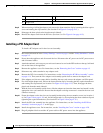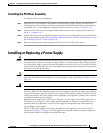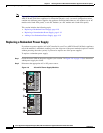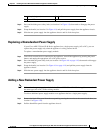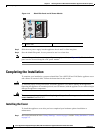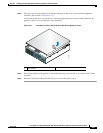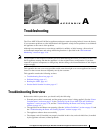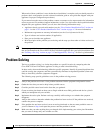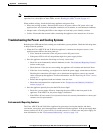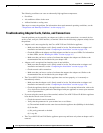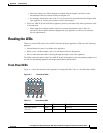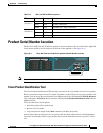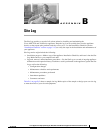
A-2
Cisco Application Deployment Engine (ADE) 2130 and 2140 Series Appliance Hardware Installation Guide
78-18579-02
Appendix A Troubleshooting
Problem Solving
When each of these conditions is met, the hardware installation is complete, and you should proceed to
perform a basic configuration (see the software installation guide or user guide that shipped with your
appliance for proper configuration procedures).
If you cannot locate the source of the problem, contact a customer service representative for information
on how to proceed. For technical support information, see the Cisco Information Packet publication that
shipped with your appliance. Before you call, have the following information ready:
• Appliance chassis type and serial number (see the “Cisco Product Identification Tool” section on
page 1-4 or the “Cisco Product Identification Tool” section on page A-7 for more information)
• Maintenance agreement or warranty information (see the Cisco Information Packet)
• Type of software and version number (if applicable)
• Date you received the new appliance
• Brief description of the problem you are having and the steps you have taken to isolate and resolve
the problem
Note Ensure you provide the customer service representative with any upgrade or maintenance information
that was performed on the Cisco ADE 2130 and 2140 Series appliance after your initial installation. (See
the “Creating a Site Log” section on page 2-15 and Appendix B, “Site Log,” for Site Log information.)
Problem Solving
The key to problem solving is to isolate the problem to a specific location by comparing what the
Cisco ADE 2130 and 2140 Series appliance is doing to what it should be doing.
In other words, when troubleshooting, define the specific symptoms, identify all potential problems that
could be causing the symptoms, and then systematically eliminate each potential problem (from most
likely to least likely) until the symptoms disappear.
The following steps provide guidelines to use in the problem-solving process:
Step 1 Analyze the problem and create a clear problem statement. Define symptoms and potential causes.
Step 2 Gather the facts that you need to help isolate possible causes.
Step 3 Consider possible causes based on the facts that you gathered.
Step 4 Create an action plan based on those causes. Begin with the most likely problem and devise a plan in
which you manipulate only one variable.
Step 5 Implement the action plan. Perform each step carefully while testing to see whether the symptom
disappears.
Step 6 Analyze the results to determine whether the problem has been resolved. If the problem was resolved,
consider the process complete.
Step 7 If the problem has not been resolved, create an action plan based on the next most probable cause on
your list. Return to Step 4 and repeat the process until the problem is solved.
Step 8 Make sure that you undo anything that you changed while implementing your action plan. Remember
that you want to change only one variable at a time.



